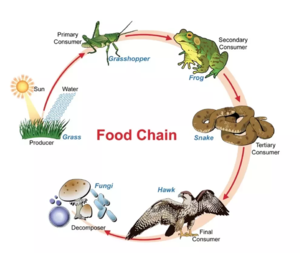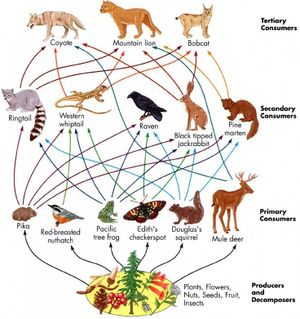Food chains
Definition

Food chains are described as sequences of transfers of energy in the form of food from one organism to another organism. Food chains commonly intertwine into a food web as most organisms feed on more than one species of animal or plant. Plants that convert solar energy to glucose through the process of photosynthesis are the primary source of food for all life. [1]
In predator chains plant-eating animals are eaten by a carnivorous animal. In a parasite chain small organisms consume part of a host. In a saprophytic chain, microorganisms feed and live on dead organic matter. [2]
Because energy is lost at each trophic level, chains do not usually incorporate more than four trophic levels. Humans are able to increase the total food supply by cutting out one step in the food chain. For example, instead of consuming animals that eat cereal grains, the people themselves consume the grains. Because the food chain is made shorter, the total amount of energy available to the final consumers is increased which in turn forms a more sustainable food production process. [3][4]
Food Web and Guilds
Since most species eat both plants and animals and more than one species, they therefore feed at more than one trophic level. In turn, food chains commonly conglomerate into complex food webs. Simplified food webs are able to show networks of numerous trophic relationships. [5]

Most communities contain groups of species known as guilds, which feed on similar resources in comparable ways. Guilds stresses that these groups are associations of likeminded species who incorporate similar methods in plying their trade. Guilds could consist of different insect species that collect nectar in similar ways, various bird species that employ corresponding insect-foraging techniques, or diverse plant species that have evolved comparable floral shapes with which they attract the same group of pollinators. [3]
Guilds are made of groups of closely connected species that originated from a mutual ancestor. These guilds use resources similarly because of their shared ancestry. [2]
Keystone Species
A fully constructed food web can provide an artificial and fixed interpretation of the structure of communities. Not every relationships between species are equally important in the dynamics and evolution of populations and the organization of communities. Food webs include both strong and weak interactions between species, and these differences in interaction strength influence the organization of communities. Some species, called keystone species, have a disproportionately large effect on the communities in which they occur. They help to maintain local diversity within a community either by controlling populations of species that would otherwise dominate the community or by providing critical resources for a wide range of species. [1]
Interspecific Interactions
Since members of one guild involve themselves similar doings they are often competitors for a mutual resources, mainly when resources are uncommon. Competition within guilds the structure of their community is built on other interaction. Species eat each other, compete for resources, which in turn creates a variety of interspecific among intraspecific interactions. Most species interact cooperatively to search for food or avoid predators where these relationships between species are important as food chains and food webs in shaping the organization of biological communities. [1][2][3]
References
[1] Thompson, J. N. (2019, January 15). Community ecology. Retrieved from https://www.britannica.com/science/community-ecology
[2] Elton, C. S. (1927). Animal Ecology. London, UK.: Sidgwick and Jackson. ISBN 0-226-20639-4.
[3] Egerton, F. N. (2007). "Understanding food chains and food webs, 1700-1970". Bulletin of the Ecological Society of America. 88: 50–69. doi:10.1890/0012-9623(2007)88[50:UFCAFW]2.0.CO;2.
[4] Pimm S.L. (1982) Food webs. In: Food Webs. Population and Community Biology. Springer, Dordrecht
[5] Cohen J. E., Briand F., Newman C. M. and Steele J. H. A stochastic theory of community food webs. III. Predicted and observed lengths of food chains228Proceedings of the Royal Society of London. Series B. Biological Sciences